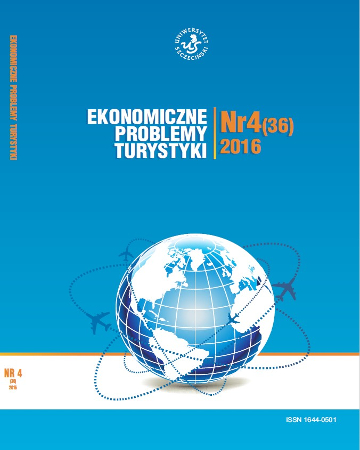
ISSN: 1644-0501
eISSN: 2353-3188
OAI
DOI: 10.18276/ept.2017.4.40-08



Issue archive /
nr 4 (40) 2017
Urban Pilgrims Tourism – Local Community And Visitors Perspective (St. Stanislaus Kostka Sanctuary In Warsaw)
| Authors: |
Anna
Pawlikowska-Piechotka
Faculty of Tourism and Recreation WTIR AWF Warsaw Anna Ostrowska-Tryzno Faculty of Tourism and Recreation WTIR AWF Warsaw Karolina Gołębieska Faculty of Tourism and Recreation WTIR AWF Warsaw |
| Keywords: | urban tourism sacred sites pilgrims sustainable spatial planning local community |
| Data publikacji całości: | 2017-12-30 |
| Page range: | 9 (93-101) |
| Klasyfikacja JEL: | Z32 |
Abstract
Today we can observe an increasing popularity of short-term pilgrimage visits, religious excursions to the urban sacred centres. On the example of St. Stanislaus Kostka Church in Warsaw, we intended to study the impact that tourism is having on the nearby housing estate and local community (Żoliborz Borough, Warsaw). The basic issue of our study (conducted in the Faculty of Tourism and Recreation, AWF University Warsaw: 2014–2016) was to seek the answer for the following questions: the number of visitors, how much income they inject into the local economy, the number of jobs created, the impact of tourism on the image of the city, the local community’s approach to tourists as “strangers”, and also the visitor comments on amenities and infrastructure. To examine urban tourism from the local community perspective and to obtain primary data, we have undertaken the explanatory research (based on observation and social survey work as a basis to explain a phenomenon) and evaluative research (policy of St. Stanislaus Kostka Church and local authorities decision-making grounds associated with the pilgrimage tourism process. We also used statistic information (as secondary data). Social-science perspectives and spatial studies showed that shared space (tourists, local community) creates some conflicts, such as problems with parking space, overcrowded local shops, and much higher prices than in shops located in the nearby districts. On the other hand, local community is clearly proud of such an important holy site. It would seem that more attention should be paid to the negative consequences of visitor’s presence and that it is necessary to identify in future local plans more carefully several issues connected with tourist presence.
Download file
Article file
Bibliography
| 1. | Archer, B., Cooper, Ch., Ruhanem, L. (2005). The Positive and Negative Impacts of Tourism. Global Tourism (Theobald William F. edit.). 75–103; Elsevier New York. |
| 2. | Dallen, J.T., Stephen, W.B. (2003). Heritage Tourism. Harlow Essex: Prentice Hall. |
| 3. | Dredge, D., Moore, S. (1992). A methodology for the integration of tourism in town planning, Journal of Tourism Studies, 3 (3–1), 8–27. |
| 4. | Drost, A. (1996). Developing sustainable tourism for world heritage sites. Annals of Tourism Research, 2 (23), 479–484. DOI: 10.1016/0160-7383(96)83345-7. |
| 5. | European Commission. Regional Policy (2011). Cities of tomorrow. Challenges, visions, ways forward, EC. Retrieved from: http://www.europa.eu (29.02.2016). |
| 6. | Finn, M.; Elliott-White, M.; Walton, M. (2000). Tourism and Leisure Research Methods. Pearson London. |
| 7. | Hall, M.C. (2000). Tourism Planning. Harlow Essex: Prentice Hall. |
| 8. | Harrison, D., Hitchcock, M. (2005). The politics of world heritage. Negotiating tourism and conservation. Paris: UNESCO World Heritage Centre. |
| 9. | Inskeep, E. (1991). Tourism planning: an integrated and sustainable development approach. New York: Van Nostrand Reinhold. |
| 10. | Kapera, I. (2011). Samorząd terytorialny a rozwój turystyki religijnej i pielgrzymkowej w Krakowie. Zeszyty Naukowe Uniwersytetu Szczecińskiego, Turystyka religijna – zagadnienia interdyscyplinarne, 647, 271–282. |
| 11. | Kazimierczak, M. (2012). Duchowy wymiar podróżowania. Folia Turistica, 27, 5–21. |
| 12. | Korstanje, M.E. (2011). Influence of history in the encounter of guests and hosts. Anatolia, 2 (22), 282–285. |
| 13. | Kowalczyk, A.(2013). Turystyka kulturowa. Warszawa: Wydawnictwo Naukowe PWN. |
| 14. | Kowalczyk, A. (2010). Turystyka zrównoważona. Warszawa: Wydawnictwo Naukowe PWN. |
| 15. | Kowalski, T., Ruszkowski, M. (2011). Miejsca kultu religijnego jako czynnik atrakcyjności regionu, Zeszyty Naukowe Uniwersytetu Szczecińskiego, 647, 71–84. |
| 16. | Kurek W. (2012). Turystyka. Warszawa: Wydawnictwo Naukowe PWN. |
| 17. | Lovelock, B., Lovelock, K.M. (2013). The Ethics of Tourism. Critical and Applied Perspectives. New York: Routledge. |
| 18. | Law, M.Ch. (2002): Urban Tourism. London: Continuum. |
| 19. | Lomine, L., Edmunds, J. (2007). Key Concepts in Tourism. New York: Palgrave. |
| 20. | Newman, P., Thornley, A. (2011). Planning World Cities. Globalisation and Urban Politics. New York: Palgrave–Macmillan. |
| 21. | Page, S.J.; Hall, C.M. (2003). Managing Urban Tourism. Harlow: Prentice Hall. |
| 22. | Panasiuk, A. (2011). Dylematy promocji produktu turystyki religijnej. Zeszyty Naukowe Uniwersytetu Szczecińskiego, 647, 361–373. |
| 23. | Pawlikowska-Piechotka, A. (2009). Zagospodarowanie turystyczne i rekreacyjne. Gdynia: Novae Res. |
| 24. | Pawlikowska-Piechotka, A. (2013). Planowanie przestrzeni turystycznej. Gdynia: Novae Res. |
| 25. | Phillimore, J., Goodson, L. (2004). Qualitative Research in Tourism. New York: Routledge. |
| 26. | Mikos von Rohrsheidt, A.(2011). Faktyczna dostępność obiektów sakralnych, jako problem turystyki religijnej w Polsce. Zeszyty Naukowe Uniwersytetu Szczecińskiego 647, 35–58. |
| 27. | Rotherham, I. (2009). Sustaining Tourism Infrastructure for Religious Tourists and Pilgrims within the UK. Religious Tourism and Pilgrimage Festivals Management (pp. 64–77). London: CABI Publishing. |
| 28. | Rinchede, G. (2002). Forms of religious tourism. Annals of Tourism Research, 1 (19), 51–67. |
| 29. | Selby, M. (2004). Understanding Urban Tourism. London: I.B. TAURIS. |
| 30. | Smith, M.K. (2003). Issues in Cultural Tourism Studies. New York: Routledge. |
| 31. | Swatos, W.H., Tomasi, L. (2002). From Medieval pilgrimage to religious tourism. Chicago: Praeger Publishers. |
| 32. | Timothy, D.J., Boyd, S.W. (2003). Heritage Tourism. Harlow: Prentice Hall. |
| 33. | UNESCO ICOMOS (2011). The Valetta Principles for the Safeguarding and Management of Historic Cities, Towns and Urban Areas. Paris: UNESCO. |
| 34. | Vael, A.J. (2002). Leisure and Tourism. Policy and Planning. London–New York: Routledge. |